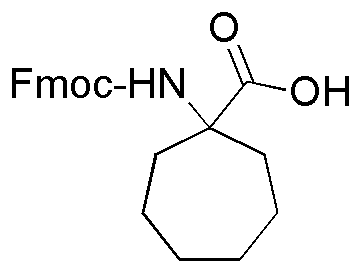Fmoc-1-amino-1-cycloheptanecarboxylic acid is widely utilized in research focused on:
- Peptide Synthesis: This compound serves as a protective group in solid-phase peptide synthesis, allowing for the selective modification of amino acids without affecting the rest of the peptide chain.
- Drug Development: Its unique structure makes it valuable in the design of novel pharmaceuticals, particularly in the development of cyclic peptides that can exhibit enhanced biological activity.
- Bioconjugation: The compound can be used to create bioconjugates, linking peptides to various biomolecules, which is essential in the development of targeted drug delivery systems.
- Research in Neuroscience: Its derivatives are being explored for their potential applications in neuropharmacology, particularly in the study of receptor interactions and signaling pathways.
- Material Science: The compound can be incorporated into polymeric materials to enhance their properties, such as flexibility and thermal stability, making it useful in the development of advanced materials.
General Information
Properties
Safety and Regulations
Applications
Fmoc-1-amino-1-cycloheptanecarboxylic acid is widely utilized in research focused on:
- Peptide Synthesis: This compound serves as a protective group in solid-phase peptide synthesis, allowing for the selective modification of amino acids without affecting the rest of the peptide chain.
- Drug Development: Its unique structure makes it valuable in the design of novel pharmaceuticals, particularly in the development of cyclic peptides that can exhibit enhanced biological activity.
- Bioconjugation: The compound can be used to create bioconjugates, linking peptides to various biomolecules, which is essential in the development of targeted drug delivery systems.
- Research in Neuroscience: Its derivatives are being explored for their potential applications in neuropharmacology, particularly in the study of receptor interactions and signaling pathways.
- Material Science: The compound can be incorporated into polymeric materials to enhance their properties, such as flexibility and thermal stability, making it useful in the development of advanced materials.
Documents
Safety Data Sheets (SDS)
The SDS provides comprehensive safety information on handling, storage, and disposal of the product.
Product Specification (PS)
The PS provides a comprehensive breakdown of the product’s properties, including chemical composition, physical state, purity, and storage requirements. It also details acceptable quality ranges and the product's intended applications.
Certificates of Analysis (COA)
Search for Certificates of Analysis (COA) by entering the products Lot Number. Lot and Batch Numbers can be found on a product’s label following the words ‘Lot’ or ‘Batch’.
Numéro de catalogue
Numéro de lot/série
Certificates Of Origin (COO)
This COO confirms the country where the product was manufactured, and also details the materials and components used in it and whether it is derived from natural, synthetic, or other specific sources. This certificate may be required for customs, trade, and regulatory compliance.
Numéro de catalogue
Numéro de lot/série
Safety Data Sheets (SDS)
The SDS provides comprehensive safety information on handling, storage, and disposal of the product.
DownloadProduct Specification (PS)
The PS provides a comprehensive breakdown of the product’s properties, including chemical composition, physical state, purity, and storage requirements. It also details acceptable quality ranges and the product's intended applications.
DownloadCertificates of Analysis (COA)
Search for Certificates of Analysis (COA) by entering the products Lot Number. Lot and Batch Numbers can be found on a product’s label following the words ‘Lot’ or ‘Batch’.
Numéro de catalogue
Numéro de lot/série
Certificates Of Origin (COO)
This COO confirms the country where the product was manufactured, and also details the materials and components used in it and whether it is derived from natural, synthetic, or other specific sources. This certificate may be required for customs, trade, and regulatory compliance.


